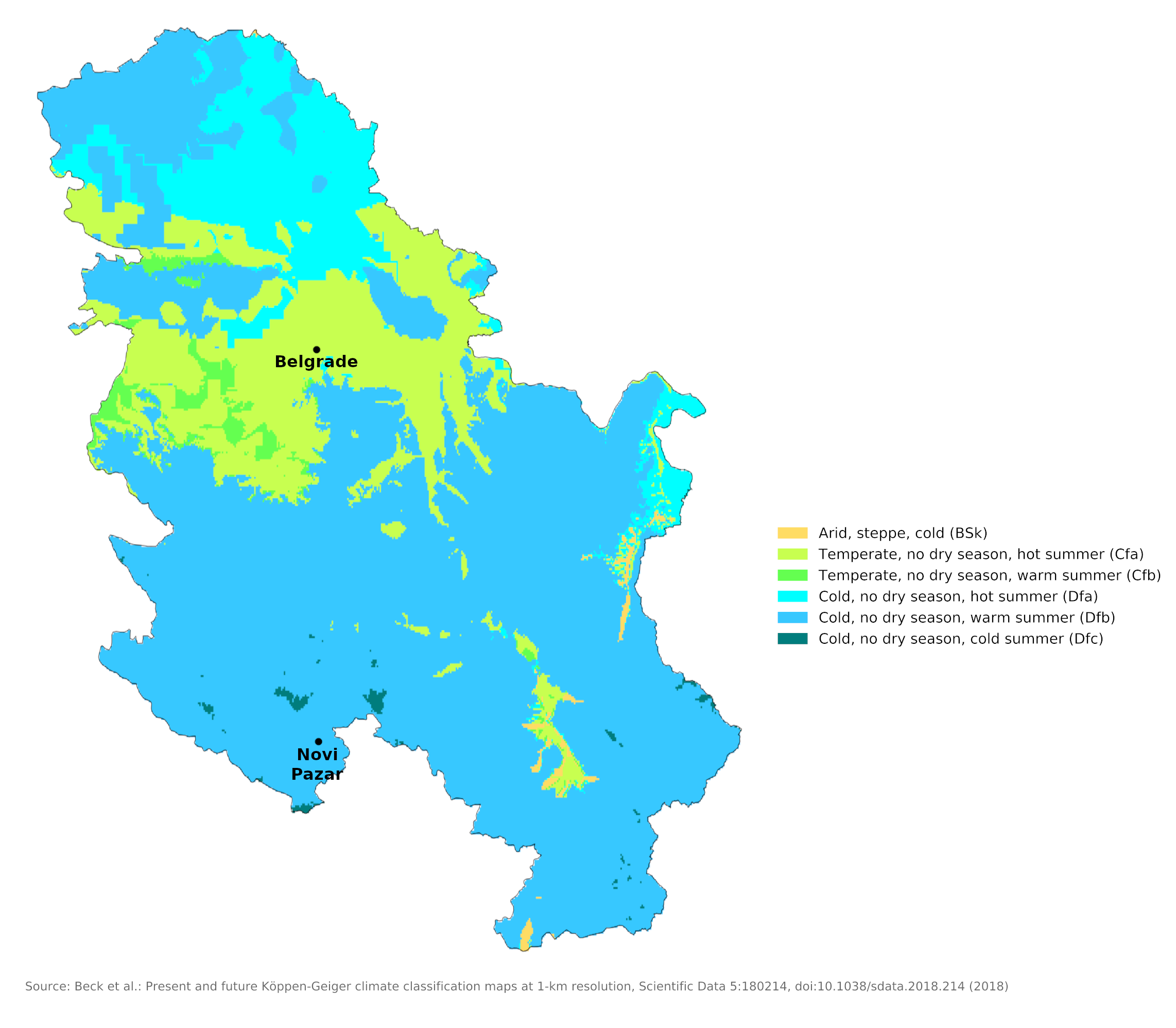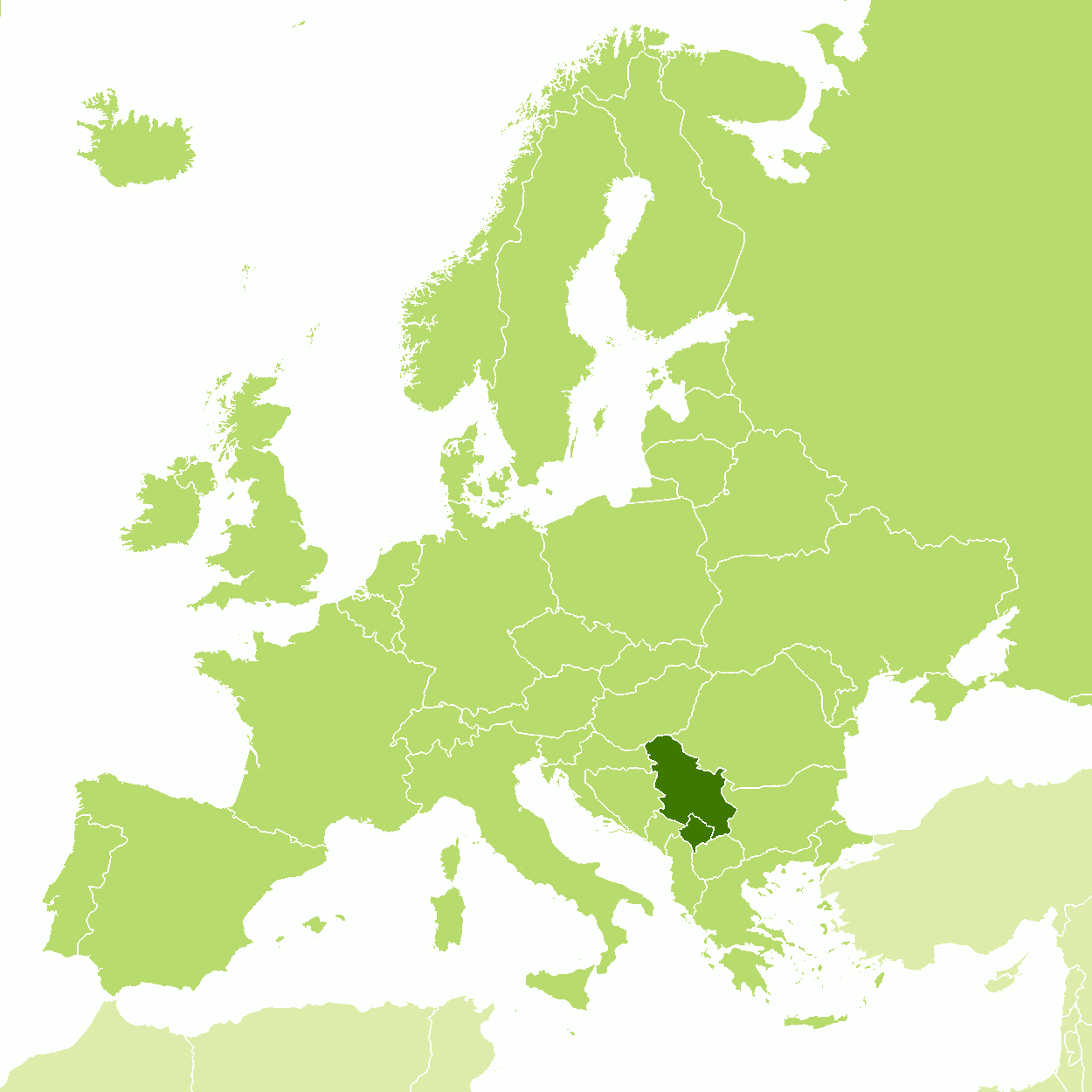The Climate of
Serbia
 The river Sava from the Branko's Bridge in Belgrade
The river Sava from the Branko's Bridge in Belgrade
Climate Map
 Climate map of Serbia
Climate map of Serbia
What is the climate of Serbia like?
Serbia is located in southeastern Europe, sharing borders with Hungary, Romania, Bulgaria, North Macedonia, Montenegro, Croatia, and Bosnia and Herzegovina.
Most of Serbia's climate is continental, with conditions typical of eastern Europe—cold, dry winters and warm, humid summers, but the climate of its mountains and interior plain varies considerably according to elevation and distance from the sea.
Snow blankets most of the highlands during the winter. In the mountainous parts, the climate even becomes sub-alpine, with cold, snowy winters and mild summers. In some of these areas, snow lingers into the summer months; the highest mountain peaks are covered with snow year-round.
Serbia includes much low-lying land in the valleys of the Danube, Drave, and Save; here winters are rather cold and rainfall lower. A dry wind, the košava, brings freezing air from central Eurasia in the winter, but snowfall is usually light. In the north, summers are hot, humid and continental, but the south is subject to strong Mediterranean influences and summers are drier.Annual rainfall in Serbia ranges from 560 to 1,900 millimeters (22 to 75 inches), depending on altitude and exposure. Heavy rains in spring and autumn can cause floods.
The climate of Belgrade represents conditions in lowland areas of Serbia. The climate of Novi Pazar shows the cooler conditions in the hilly southwest.
| Climate data for Belgrade (1991–2020) | |||||||||||||
|---|---|---|---|---|---|---|---|---|---|---|---|---|---|
| Month | Jan | Feb | Mar | Apr | May | Jun | Jul | Aug | Sep | Oct | Nov | Dec | Year |
| Average high °C (°F) | 5.2 (41.4) | 7.8 (46.0) | 13.1 (55.6) | 18.9 (66.0) | 23.6 (74.5) | 27.1 (80.8) | 29.3 (84.7) | 29.7 (85.5) | 24.3 (75.7) | 18.7 (65.7) | 12.2 (54.0) | 6.1 (43.0) | 18.0 (64.4) |
| Daily mean °C (°F) | 1.9 (35.4) | 3.8 (38.8) | 8.3 (46.9) | 13.6 (56.5) | 18.2 (64.8) | 21.9 (71.4) | 23.8 (74.8) | 23.8 (74.8) | 18.5 (65.3) | 13.3 (55.9) | 8.1 (46.6) | 3.0 (37.4) | 13.0 (55.4) |
| Average low °C (°F) | −0.7 (30.7) | 0.6 (33.1) | 4.2 (39.6) | 8.8 (47.8) | 13.2 (55.8) | 16.7 (62.1) | 18.4 (65.1) | 18.5 (65.3) | 14.1 (57.4) | 9.4 (48.9) | 5.1 (41.2) | 0.5 (32.9) | 9.1 (48.4) |
| Average precipitation mm (inches) | 47.9 (1.89) | 43.5 (1.71) | 48.7 (1.92) | 51.5 (2.03) | 72.3 (2.85) | 95.6 (3.76) | 66.5 (2.62) | 55.1 (2.17) | 58.6 (2.31) | 54.8 (2.16) | 49.6 (1.95) | 54.8 (2.16) | 698.9 (27.52) |
| Source: Republic Hydrometeorological Service of Serbia | |||||||||||||
| Climate data for Novi Pazar | |||||||||||||
|---|---|---|---|---|---|---|---|---|---|---|---|---|---|
| Month | Jan | Feb | Mar | Apr | May | Jun | Jul | Aug | Sep | Oct | Nov | Dec | Year |
| Average high °C (°F) | 2.7 (36.9) | 5.6 (42.1) | 11.1 (52.0) | 15.5 (59.9) | 20.1 (68.2) | 23.6 (74.5) | 26.1 (79.0) | 26.4 (79.5) | 22.7 (72.9) | 16.5 (61.7) | 8.8 (47.8) | 4.3 (39.7) | 15.3 (59.5) |
| Daily mean °C (°F) | −0.6 (30.9) | 1.6 (34.9) | 6.3 (43.3) | 10.2 (50.4) | 14.6 (58.3) | 18.0 (64.4) | 20.1 (68.2) | 20.1 (68.2) | 16.7 (62.1) | 11.4 (52.5) | 5.2 (41.4) | 1.2 (34.2) | 10.4 (50.7) |
| Average low °C (°F) | −3.9 (25.0) | −2.4 (27.7) | 1.5 (34.7) | 5.0 (41.0) | 9.2 (48.6) | 12.5 (54.5) | 14.1 (57.4) | 13.8 (56.8) | 10.7 (51.3) | 6.4 (43.5) | 1.6 (34.9) | −1.8 (28.8) | 5.6 (42.0) |
| Average precipitation mm (inches) | 71 (2.8) | 64 (2.5) | 66 (2.6) | 74 (2.9) | 92 (3.6) | 78 (3.1) | 68 (2.7) | 62 (2.4) | 69 (2.7) | 80 (3.1) | 93 (3.7) | 83 (3.3) | 900 (35.4) |
| Source: Climate-Data.org | |||||||||||||
References
- E. A. Pearce, Charles Gordon Smith, (1990) The Hutchinson World Weather Guide, John Murray Press. ISBN 1859863426
- Timothy L. Gall, (ed.), (2003), Worldmark Encyclopedia of the Nations, Eleventh Edition, Thomson Gale
- Federal Research Division, Library of Congress, (1992), Yugoslavia: a country study. Claitor's Pub. Division. ISBN 0844407356
- Hugh Chisholm, (ed.), (1911), Encyclopædia Britannica, Eleventh edition, Cambridge University Press
The Climate of
Serbia

In summary:
Serbia's climate ranges from continental in the north to Mediterranean in the south, with sub-alpine conditions prevailling in the high mountains. Winters are typically cold and dry; summers are warm and humid.
Rainfall averages 700 mm (28 in) in lowland areas, and is often heaviest in early summer.